2011 Hyundai Sonata Hybrid brake
[x] Cancel search: brakePage 12 of 404
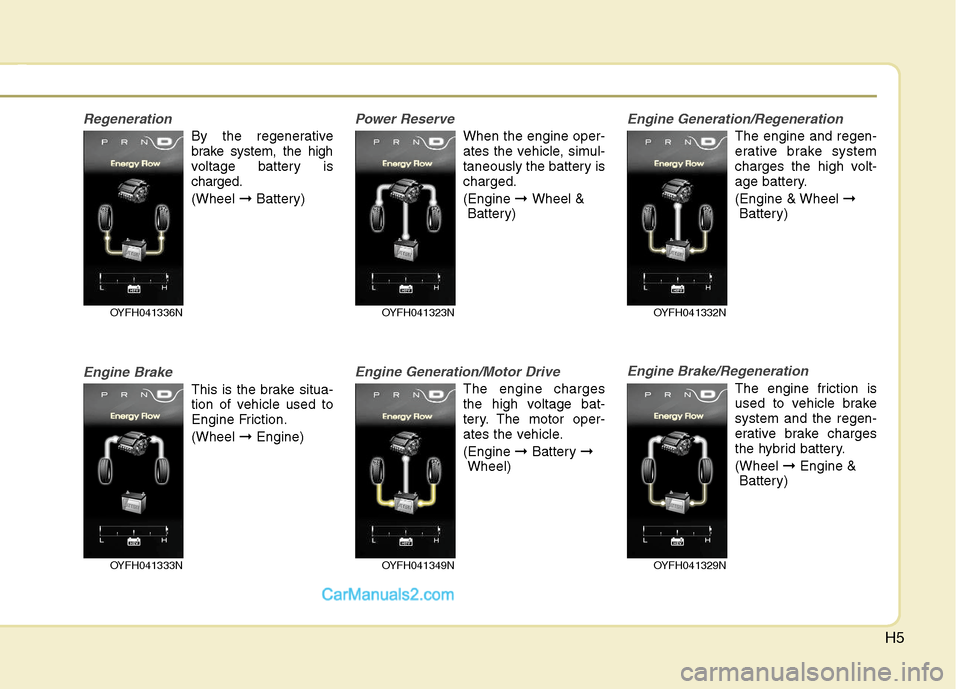
H5
Regeneration
By the regenerative
brake system, the high
voltage battery is
charged.
(Wheel ➞Battery)
Engine Brake
This is the brake situa-
tion of vehicle used to
Engine Friction.
(Wheel ➞Engine)
Power Reserve
When the engine oper-
ates the vehicle, simul-
taneously the battery is
charged.
(Engine ➞ Wheel &
Battery)
Engine Generation/Motor Drive
The engine charges
the high voltage bat-
tery. The motor oper-
ates the vehicle.
(Engine ➞Battery ➞
Wheel)
Engine Generation/Regeneration
The engine and regen-
erative brake system
charges the high volt-
age battery.
(Engine & Wheel ➞
Battery)
Engine Brake/Regeneration
The engine friction is
used to vehicle brake
system and the regen-
erative brake charges
the hybrid battery.
(Wheel ➞Engine &
Battery)
OYFH041336N
OYFH041333NOYFH041349N
OYFH041323N
OYFH041329N
OYFH041332N
Page 13 of 404

H6
Starting the engine
1. Carry the smart key or leave it inside
the vehicle.
2. Make sure the parking brake is firmly
applied.
3. Place the shift lever in the P(Park)
position. In N(Neutral) position, you
can not start the vehicle.
4. Depress the brake pedal.
5. Press the engine start/stop button.
6. In extremely cold weather or after the
vehicle has not been operated for sev-
eral days, let the engine warm up with-
out depressing the accelerator.
Whether the engine is cold or warm, it
should be started without depressing
the accelerator.
if it is far away from you, the engine
may not start.
in the ACC or ON position, if any door
is open, the system checks for the
smart key. If the smart key is not in
the vehicle, the warning, "Key is not
in vehicle" will come on, and if all
doors are closed, the chime will also
sound for about 5 seconds. The indi-
cator will turn off while the vehicle is
moving. Keep the smart key in the
vehicle when using the ACC position
or if the vehicle engine is on.IF the starting procedure is followed,
the "READY" symbol on the instru-
ment cluster will turn on. For more
details, Please check chapter 5.
ECONOMICAL and SAFE OPERA-
TION of Hybrid system
Drive smoothly. Accelerate at a mod-
erate rate and maintain a steady cruis-
ing speed. Don't make "jack-rabbit"
starts. Don't race between stoplights.
Avoid heavy traffic whenever possible.
Always maintain a safe distance from
other vehicles so you can avoid unnec-
essary braking. This also reduces
brake wear.
The regenerative brake generates
energy when the vehicle decelerates.
When the hybrid battery power is low,
the hybrid system automatically
recharges the hybrid battery.
When the engine runs in "N" position,
the hybrid system can not generate
electricity. The hybrid battery cannot
recharge in "N" position. Please check
chapter 5.
✽ ✽
NOTICE
In the hybrid system, the engine auto-
matically runs and stops. If the hybrid
system operates, the "READY" symbol
is illuminated.
In the following situation, the engine
may operate automatically.
- When the engine is ready to run
- When the hybrid battery is charged
- Depending on the temperature condi-
tion of the hybrid battery
STARTING THE HYBRID VEHICLE (SMART KEY)
Page 14 of 404
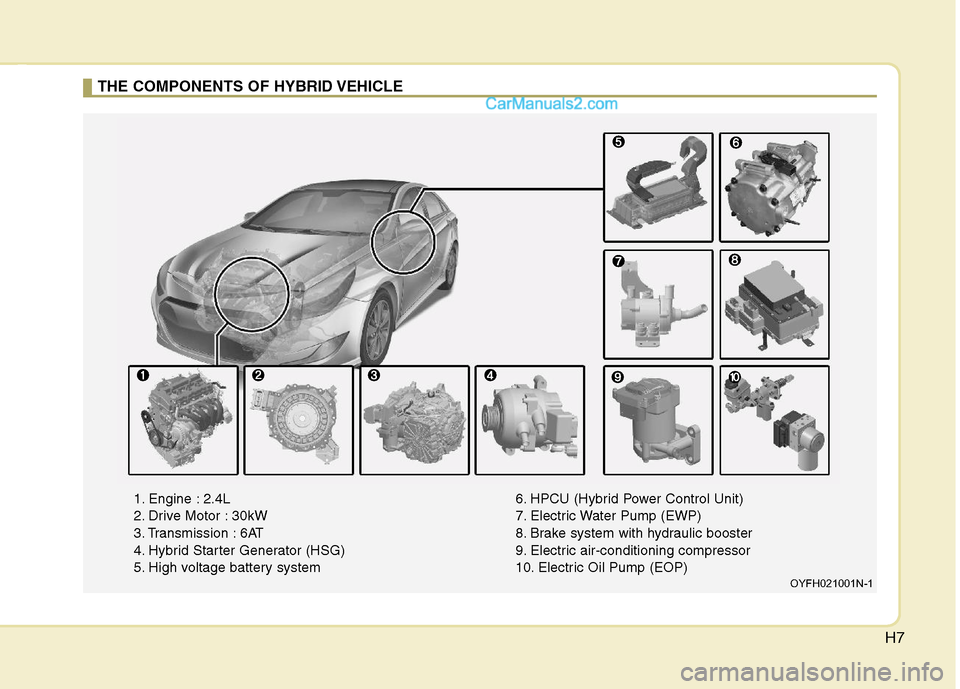
H7
THE COMPONENTS OF HYBRID VEHICLE
OYFH021001N-1
1. Engine : 2.4L
2. Drive Motor : 30kW
3. Transmission : 6AT
4. Hybrid Starter Generator (HSG)
5. High voltage battery system6. HPCU (Hybrid Power Control Unit)
7. Electric Water Pump (EWP)
8. Brake system with hydraulic booster
9. Electric air-conditioning compressor
10. Electric Oil Pump (EOP)
Page 18 of 404
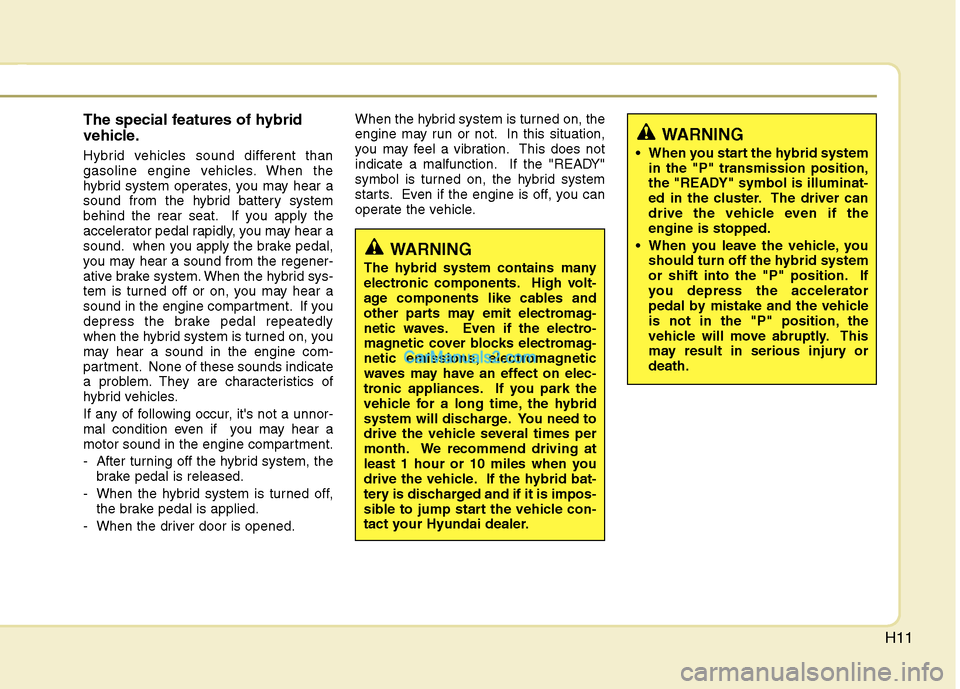
H11
The special features of hybrid
vehicle.
Hybrid vehicles sound different than
gasoline engine vehicles. When the
hybrid system operates, you may hear a
sound from the hybrid battery system
behind the rear seat. If you apply the
accelerator pedal rapidly, you may hear a
sound. when you apply the brake pedal,
you may hear a sound from the regener-
ative brake system. When the hybrid sys-
tem is turned off or on, you may hear a
sound in the engine compartment. If you
depress the brake pedal repeatedly
when the hybrid system is turned on, you
may hear a sound in the engine com-
partment. None of these sounds indicate
a problem. They are characteristics of
hybrid vehicles.
If any of following occur, it's not a unnor-
mal condition even if you may hear a
motor sound in the engine compartment.
- After turning off the hybrid system, the
brake pedal is released.
- When the hybrid system is turned off,
the brake pedal is applied.
- When the driver door is opened.When the hybrid system is turned on, the
engine may run or not. In this situation,
you may feel a vibration. This does not
indicate a malfunction. If the "READY"
symbol is turned on, the hybrid system
starts. Even if the engine is off, you can
operate the vehicle.
WARNING
The hybrid system contains many
electronic components. High volt-
age components like cables and
other parts may emit electromag-
netic waves. Even if the electro-
magnetic cover blocks electromag-
netic emissions, electromagnetic
waves may have an effect on elec-
tronic appliances. If you park the
vehicle for a long time, the hybrid
system will discharge. You need to
drive the vehicle several times per
month. We recommend driving at
least 1 hour or 10 miles when you
drive the vehicle. If the hybrid bat-
tery is discharged and if it is impos-
sible to jump start the vehicle con-
tact your Hyundai dealer.
WARNING
When you start the hybrid system
in the "P" transmission position,
the "READY" symbol is illuminat-
ed in the cluster. The driver can
drive the vehicle even if the
engine is stopped.
When you leave the vehicle, you
should turn off the hybrid system
or shift into the "P" position. If
you depress the accelerator
pedal by mistake and the vehicle
is not in the "P" position, the
vehicle will move abruptly. This
may result in serious injury or
death.
Page 20 of 404
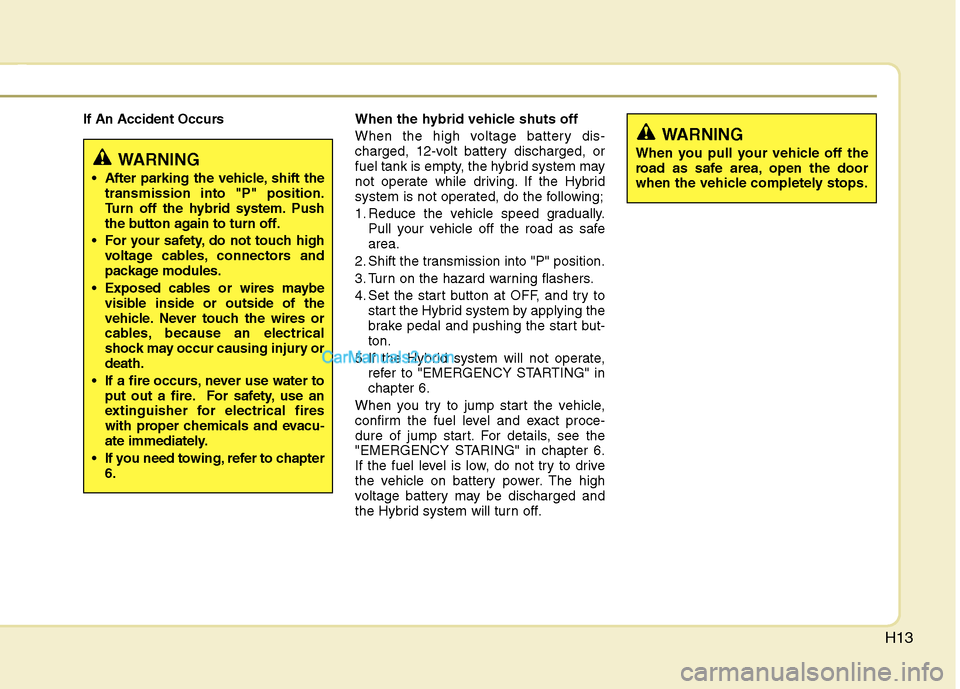
H13
If An Accident OccursWhen the hybrid vehicle shuts off
When the high voltage battery dis-
charged, 12-volt battery discharged, or
fuel tank is empty, the hybrid system may
not operate while driving. If the Hybrid
system is not operated, do the following;
1. Reduce the vehicle speed gradually.
Pull your vehicle off the road as safe
area.
2. Shift the transmission into "P" position.
3. Turn on the hazard warning flashers.
4. Set the start button at OFF, and try to
start the Hybrid system by applying the
brake pedal and pushing the start but-
ton.
5. If the Hybrid system will not operate,
refer to "EMERGENCY STARTING" in
chapter 6.
When you try to jump start the vehicle,
confirm the fuel level and exact proce-
dure of jump start. For details, see the
"EMERGENCY STARING" in chapter 6.
If the fuel level is low, do not try to drive
the vehicle on battery power. The high
voltage battery may be discharged and
the Hybrid system will turn off.
WARNING
After parking the vehicle, shift the
transmission into "P" position.
Turn off the hybrid system. Push
the button again to turn off.
For your safety, do not touch high
voltage cables, connectors and
package modules.
Exposed cables or wires maybe
visible inside or outside of the
vehicle. Never touch the wires or
cables, because an electrical
shock may occur causing injury or
death.
If a fire occurs, never use water to
put out a fire. For safety, use an
extinguisher for electrical fires
with proper chemicals and evacu-
ate immediately.
If you need towing, refer to chapter
6.
WARNING
When you pull your vehicle off the
road as safe area, open the door
when the vehicle completely stops.
Page 25 of 404
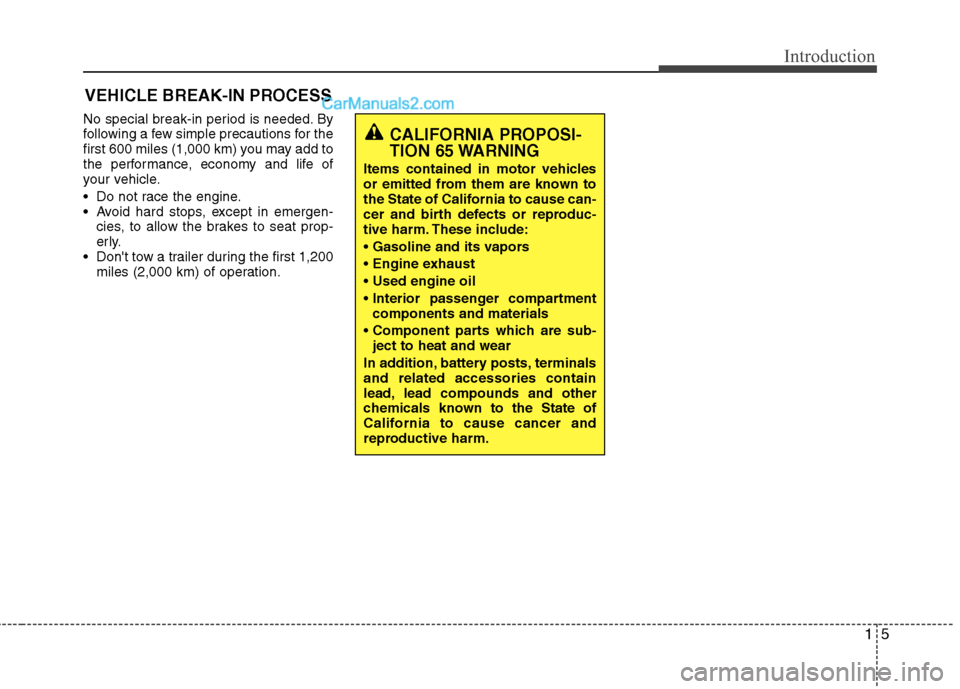
15
Introduction
No special break-in period is needed. By
following a few simple precautions for the
first 600 miles (1,000 km) you may add to
the performance, economy and life of
your vehicle.
Do not race the engine.
Avoid hard stops, except in emergen-
cies, to allow the brakes to seat prop-
erly.
Don't tow a trailer during the first 1,200
miles (2,000 km) of operation.
VEHICLE BREAK-IN PROCESS
CALIFORNIA PROPOSI-
TION 65 WARNING
Items contained in motor vehicles
or emitted from them are known to
the State of California to cause can-
cer and birth defects or reproduc-
tive harm. These include:
components and materials
ject to heat and wear
In addition, battery posts, terminals
and related accessories contain
lead, lead compounds and other
chemicals known to the State of
California to cause cancer and
reproductive harm.
Page 26 of 404
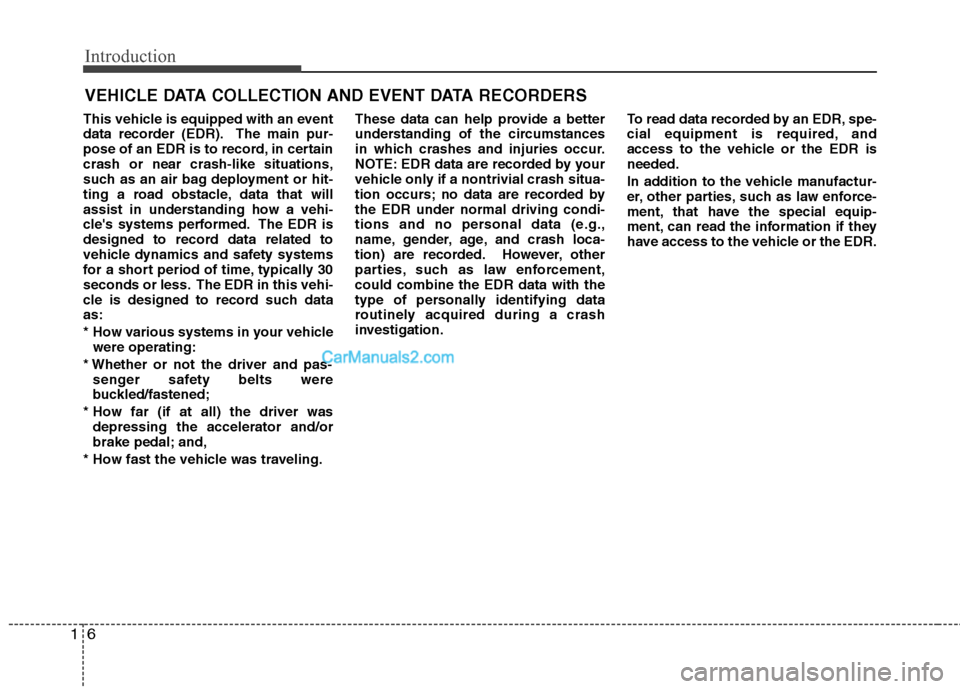
Introduction
6 1
This vehicle is equipped with an event
data recorder (EDR). The main pur-
pose of an EDR is to record, in certain
crash or near crash-like situations,
such as an air bag deployment or hit-
ting a road obstacle, data that will
assist in understanding how a vehi-
cle's systems performed. The EDR is
designed to record data related to
vehicle dynamics and safety systems
for a short period of time, typically 30
seconds or less. The EDR in this vehi-
cle is designed to record such data
as:
* How various systems in your vehicle
were operating:
* Whether or not the driver and pas-
senger safety belts were
buckled/fastened;
* How far (if at all) the driver was
depressing the accelerator and/or
brake pedal; and,
* How fast the vehicle was traveling.These data can help provide a better
understanding of the circumstances
in which crashes and injuries occur.
NOTE: EDR data are recorded by your
vehicle only if a nontrivial crash situa-
tion occurs; no data are recorded by
the EDR under normal driving condi-
tions and no personal data (e.g.,
name, gender, age, and crash loca-
tion) are recorded. However, other
parties, such as law enforcement,
could combine the EDR data with the
type of personally identifying data
routinely acquired during a crash
investigation.To read data recorded by an EDR, spe-
cial equipment is required, and
access to the vehicle or the EDR is
needed.
In addition to the vehicle manufactur-
er, other parties, such as law enforce-
ment, that have the special equip-
ment, can read the information if they
have access to the vehicle or the EDR.
VEHICLE DATA COLLECTION AND EVENT DATA RECORDERS
Page 27 of 404
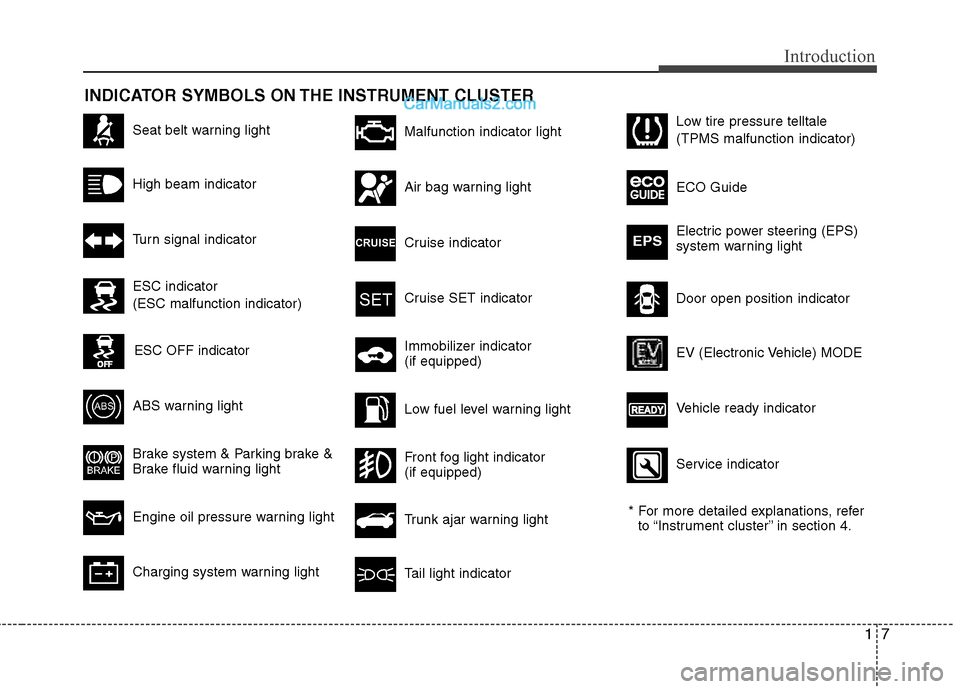
17
Introduction
INDICATOR SYMBOLS ON THE INSTRUMENT CLUSTER
Seat belt warning light
High beam indicator
Turn signal indicator
ABS warning light
Brake system & Parking brake &
Brake fluid warning light
Engine oil pressure warning light
Malfunction indicator light
Air bag warning light
Cruise indicator
Cruise SET indicator
Immobilizer indicator
(if equipped)
Low fuel level warning light
* For more detailed explanations, refer
to “Instrument cluster” in section 4.
Charging system warning lightTail light indicator
Trunk ajar warning light
Front fog light indicator
(if equipped)
Door open position indicator Low tire pressure telltale
(TPMS malfunction indicator)
ECO Guide
Electric power steering (EPS)
system warning light
EPS
ESC indicator
(ESC malfunction indicator)
ESC OFF indicator
Vehicle ready indicator EV (Electronic Vehicle) MODE
Service indicator